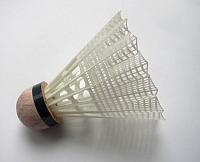This is an old revision of this page, as edited by FlaBot (talk | contribs) at 12:25, 12 August 2005 (robot Adding: de). The present address (URL) is a permanent link to this revision, which may differ significantly from the current revision.
Revision as of 12:25, 12 August 2005 by FlaBot (talk | contribs) (robot Adding: de)(diff) ← Previous revision | Latest revision (diff) | Newer revision → (diff)

A shuttlecock is a high-drag projectile used in the sport of badminton. It has an open conical shape, with a rounded head at the apex of the cone traditionally made of cork and a skirt traditionally of sixteen overlapping goose feathers.
For most casual players, the cork-and-feather construction has been replaced by the use of a plastic (usually nylon) or rubber head and a plastic (usually nylon) skirt. The feather shuttlecock is still used by serious players and for competitions. The feathered variety is more expensive and far more likely to break during a match, and also has to be hit about three times as hard.
The shuttlecock is also called a "birdie", "bird", "cock" or "shuttle". The "shuttle" part of the name was probably derived from its back-and-forth motion during the game, resembling the shuttle of a loom, and the "cock" from the feathers of the traditional shuttlecock, referring to a bird's crest.
The shuttlecock's shape makes it extremely aerodynamically stable. Regardless of initial orientation, it will turn to fly head first, and remain in the head-first orientation. The feathers provide a lot of drag (less so in a plastic construction). It is this consistent high-drag behaviour that makes badminton distinctive.
The shuttlecock's aerodynamic behaviour was consciously replicated in the design of the spacecraft SpaceShipOne. Its "feathered" flight mode is a very stable high-drag configuration, used to make the flight insensitive to orientation during atmospheric reentry.
Category: